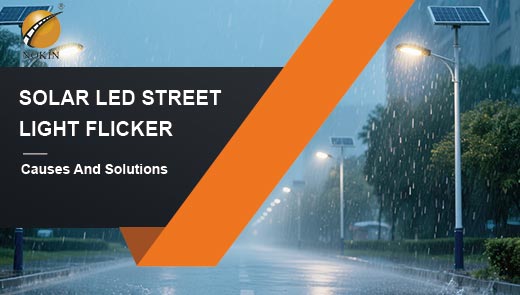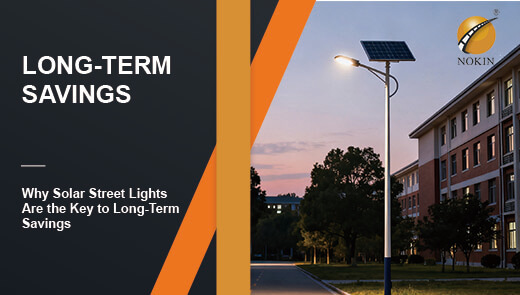Solar Street Light Pole Design: Key Considerations for Effective Installation
In modern infrastructure construction, solar street lights have gained increasing importance due to their energy-saving, environmentally friendly, and sustainable characteristics. They not only provide convenience for nighttime travel but also contribute to the development of green energy. As a crucial component of solar street lights, the design of the light pole directly impacts the effective installation and long-term stable operation of the solar street lights. A well-designed pole ensures optimal performance of the street light under various environmental conditions, while poor design may lead to functional issues, reduced lifespan, and other problems. This article will delve into the key factors to consider in solar street light pole design, including regional climate, pole materials, height, spacing, surrounding features and obstacles, as well as design aesthetics.
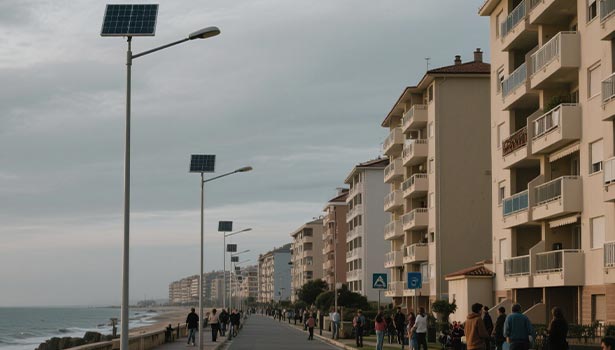
The Climate of the Area
Impact of Wind and Weather Conditions
Different regions have distinct climate characteristics. For example, some areas may experience strong hurricanes, while others may frequently encounter extreme weather conditions such as floods, snowstorms, or high temperatures. These conditions can have varying degrees of impact on solar street light poles. Wind load is a key factor in how wind forces act on the pole. If the pole is not designed to withstand wind loads, it may deform or sway, and in severe cases, fail. Additionally, as the pole height increases or when the pole has extended panels or components, the oscillating forces generated by wind may cause resonance or structural overload issues.
In high-wind-speed areas, cylindrical conical poles demonstrate significant advantages. They have excellent ventilation properties, effectively withstanding wind pressure and reducing wind force concentration on the pole. In contrast, irregularly shaped poles or rectangular poles withstand greater force when directly impacted by wind, making them more prone to damage.
Durability Against Rain, Humidity, and Corrosion
The impact of rain and humidity on solar street light poles should not be overlooked, especially in tropical or coastal regions with high humidity. Prolonged exposure to such environments can cause poles to rust, gradually weakening the entire system's strength. Selecting appropriate corrosion-resistant materials is crucial to address this issue. Aluminum, galvanized steel, and stainless steel are all suitable options. Among these, aluminum is not only lightweight but also has excellent rust-resistant properties, making it particularly suitable for high-humidity regions.
Additionally, additional protective treatments for the poles are also necessary, such as moisture-proof measures like powder coating. These treatments can further prevent rusting and ensure the poles maintain sufficient strength and an aesthetically pleasing appearance even in humid environments.
Material of the Pole
Selecting the appropriate material for the poles is a critical aspect of solar street light pole design. The selected material must be durable and weather-resistant, capable of withstanding various environmental factors such as wind, rain, and corrosion. Below are several common pole materials, their characteristics, and suitable applications:
Galvanized Steel
Galvanized steel forms a protective layer by coating the steel surface with a layer of zinc, effectively isolating air and moisture and significantly enhancing corrosion resistance. Its high strength allows it to securely support the weight of solar panels, lighting fixtures, and other components, maintaining structural stability even when exposed to outdoor conditions such as wind and sun for extended periods. Whether in urban roads, rural paths, or industrial zones, galvanized steel lamp posts reliably perform their function, making them a cost-effective and widely adopted choice in outdoor lighting applications.
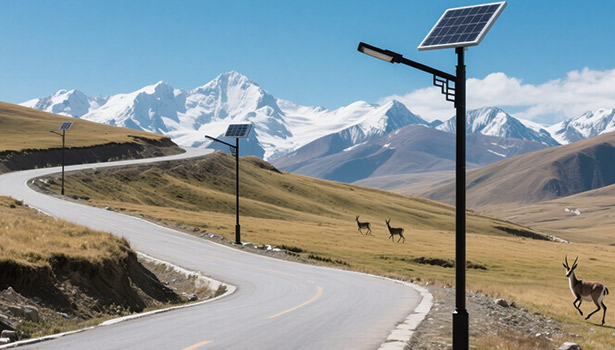
Aluminum
Aluminum has natural corrosion resistance, with an oxide film forming on its surface to prevent further oxidation. It weighs only about one-third as much as steel, reducing transportation costs and difficulties while also lowering labor and equipment requirements during installation. In areas where large lifting equipment is impractical, such as narrow alleys or around historic buildings, the lightweight advantage of aluminum lamp posts is particularly evident, while still meeting structural strength requirements for general applications.
Stainless Steel
Stainless steel contains alloy elements such as chromium and nickel, forming a dense oxide film that enables it to resist rust and staining even in harsh environments such as coastal areas with high humidity and salt fog, or areas with industrial exhaust fumes and dust. Its surface is smooth and clean, with a modern metallic texture and strong aesthetic appeal. Moreover, stainless steel has a service life of several decades and does not require frequent replacement. Although the initial cost is higher, the long-term maintenance cost is low, making it suitable for locations with high requirements for appearance and durability.
Fiberglass
Fiberglass is composed of glass fibers and resin, offering lightweight yet high strength with excellent corrosion resistance, unlike metal materials that may rust. As a non-conductive material, it reduces the risk of electric shock when used in areas prone to thunderstorms or locations with electrical equipment. Additionally, its material properties enable it to better withstand high wind speeds and extreme temperature fluctuations. In regions prone to typhoons, cold climates, or chemical industrial zones, fiberglass lamp posts offer superior stability and safety.
Pole Height
Choosing the Right Height for Solar Street Light Poles
The height of the pole directly affects the lighting coverage and effectiveness of solar street lights. If the pole height is inappropriate, it may result in an insufficient lighting range that fails to meet actual needs, or issues such as uneven lighting or glare.
Typically, the height of solar street light poles ranges from 9 to 14 feet, but in actual applications, adjustments must be made based on specific usage requirements and environmental conditions. For example, in some special locations, taller or shorter poles may be needed to achieve the desired lighting effect.
Factors Influencing Pole Height
The type of lighting fixture (illumination equipment) and the required light concentration in the area are key factors in determining pole height. Different lighting fixtures have distinct light distribution characteristics and require corresponding pole heights to achieve optimal performance. In different scenarios, the requirements for pole height also vary. For example, in busy highways, large parking lots, and parks, taller poles are needed to install higher-power lighting fixtures to expand the lighting range; however, in residential areas, to avoid glare from overly tall poles affecting residents' lives, the pole height should not be excessively high.
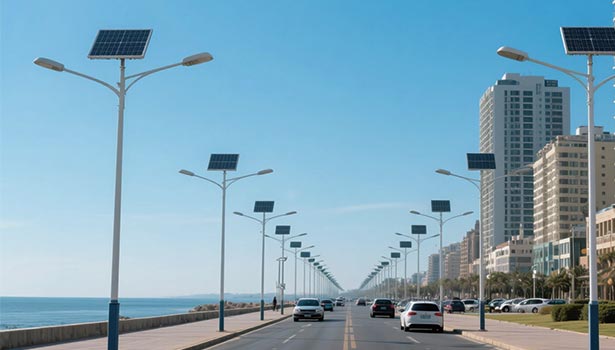
Conducting a Lighting Survey
Before determining the height of the light poles, it is essential to conduct a comprehensive outdoor lighting survey. This survey should analyze the lighting requirements of the area, including the number of solar modules needed, the power of the lighting fixtures, and the light output.
Based on the data obtained from the survey, we can determine the most suitable pole height to ensure the area achieves an appropriate peak lighting level while minimizing glare and light pollution to surrounding areas. For example, when using high-efficiency fixtures, taller poles can achieve better light distribution to meet broader lighting needs; however, if using low-power fixtures, shorter poles may already be sufficient.
Pole Spacing
Reasonable pole spacing is crucial for ensuring lighting effectiveness and cost savings. In general road lighting applications, when the road width does not exceed 15m, single-sided pole arrangement is typically adopted.
Different pole heights have varying spacing requirements. For poles under 6m in height, spacing can be set at approximately 10m; for poles over 6m in height, spacing can range from 10-25m, with specific values determined based on actual site conditions. For poles over 10m in height, there is a general spacing calculation formula: spacing = pole height ×3.
Additionally, different heights of light poles have corresponding spacing requirements under specific lighting configurations. For example, for 8m-high light poles using cross lighting, the spacing should be between 25-30m, suitable for roads 10-15m wide; for 12m-high light poles using symmetrical lighting, the longitudinal spacing should be between 30-50m, and the road lighting width must exceed 15m.
Nearby Features and Obstructions
Addressing Obstructions Like Trees and Buildings
When installing solar street lights, it is essential to fully consider surrounding obstacles such as trees and buildings. These obstacles may block light, resulting in dark areas within the lighting zone and affecting lighting effectiveness.
To address this issue, it is crucial to plan the location of the light poles reasonably, avoiding these obstacles as much as possible. If it is not possible to completely avoid them, the height or angle of the light poles can be adjusted to ensure that the light reaches the ground smoothly. Additionally, when necessary, increasing the number of light poles can also cover areas with insufficient lighting due to obstacles.
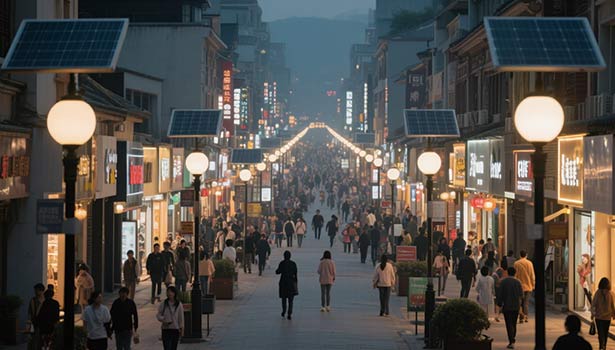
Enhancing Safety by Reducing Dark Spots
In high-crime areas, reducing dark spots is crucial for ensuring public safety. Criminals often choose to commit crimes in poorly lit areas. By reasonably designing the location of solar street light poles, the visibility of the area can be improved, thereby reducing the likelihood of crime.
For example, light poles should be installed as close as possible to entrances, sidewalks, parking lots, and other areas with high foot traffic to enhance safety in these areas. Additionally, the placement of lamp posts should avoid creating new dark spots due to self-shading. By positioning lamp posts according to the surrounding features and minimizing shadow formation, the overall safety and effectiveness of the solar street light system can be significantly enhanced.
Design and Aesthetic Considerations
While functionality is the primary consideration for solar street light poles, their design and appearance are also important in urban or residential settings. The design of the lamp posts should harmonize with the surrounding environment, blending into the landscape rather than standing out.
While pursuing aesthetic appeal, structural stability must be ensured, and functionality and safety should not be compromised for appearance. Currently, lamp posts are available in various styles, such as traditional, modern, and decorative, allowing selection based on the aesthetic requirements of different spaces.
The design of solar street light poles must comprehensively consider multiple key factors, including regional climate, pole materials, height, spacing, surrounding environment, and design aesthetics. Only by fully considering these factors can the effective installation of solar street lights be achieved, ensuring they perform optimally over the long term and provide reliable lighting for nighttime travel and daily life.


